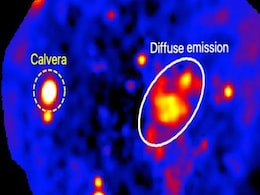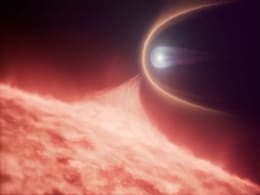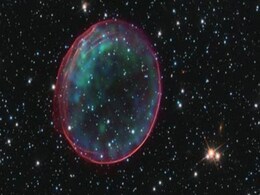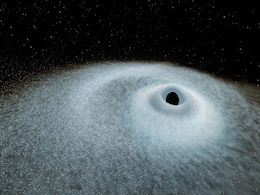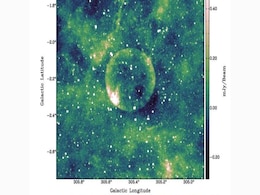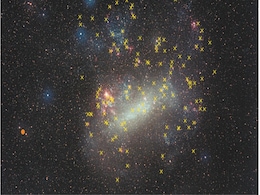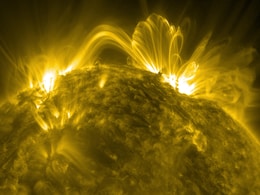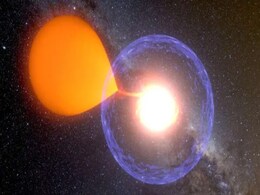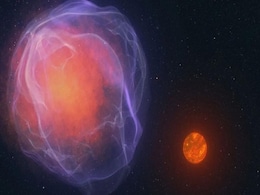Supernova Discovered
- All
- News
-

Astronomers Discover Calvera, a Runaway Pulsar Racing Above the Milky Way
- Wednesday September 3, 2025
- Written by Gadgets 360 Staff
Astronomers have discovered Calvera, a pulsar speeding 6,500 light-years above the Milky Way’s disk. Formed from a supernova in a nearly empty region, Calvera challenges long-held ideas of star birth and death. Its discovery reveals that extreme stellar events can occur even in the galaxy’s sparse outer halo.
-
 www.gadgets360.com
www.gadgets360.com
-

Hubble Discovers White Dwarf Merger Remnant with Unusual Carbon Signature
- Friday August 22, 2025
- Written by Gadgets 360 Staff
An international team of astronomers has discovered WD 0525+526, an unusual white dwarf about 128 light-years away, using NASA’s Hubble Space Telescope. Unlike typical white dwarfs, this star formed through a stellar merger and shows an unexpectedly high carbon content. With a mass of 1.2 Suns and a scorching surface temperature of 21,000 K, the ...
-
 www.gadgets360.com
www.gadgets360.com
-

Astronomers Discover a Gigantic Supernova Remnant in the Large Magellanic Cloud
- Tuesday July 1, 2025
- Written by Gadgets 360 Staff
Veliki is a newly discovered, massive supernova remnant in the Large Magellanic Cloud, observed through a global collaboration using multiwavelength astronomy tools. Estimated to be 45,000 years old, Veliki showcases complex shell structures and highly unusual radio properties.
-
 www.gadgets360.com
www.gadgets360.com
-

Astronomers Discover Most Powerful Cosmic Explosions Since the Big Bang
- Saturday June 7, 2025
- Written by Gadgets 360 Staff
Astronomers have discovered extreme nuclear transients — rare and powerful explosions caused by stars being torn apart by supermassive black holes. These events, brighter and longer-lasting than supernovae, were observed using data from Gaia and ZTF. As the most energetic cosmic outbursts since the Big Bang, they offer valuable insights into blac...
-
 www.gadgets360.com
www.gadgets360.com
-

Astronomers Discover Teleios, A Supernova Remnant with Perfect Symmetry
- Saturday May 17, 2025
- Written by Gadgets 360 Staff
A newly discovered supernova remnant named “Teleios,” meaning “perfect” in Greek, is astonishing scientists with its rare circular symmetry. Detected using data from ASKAP’s Evolutionary Map of the Universe, Teleios (G305.4–2.2) could be located 7,170 or 25,100 light years away. With a steep spectral index and low surface brightness, it...
-
 www.gadgets360.com
www.gadgets360.com
-

First Future Type 1a Supernova Detected: White Dwarf Pair to Collide in 23 Billion Years
- Tuesday April 8, 2025
- Written by Gadgets 360 Staff
Astronomers have discovered a pair of white dwarf stars located about 150 light-years from Earth that are on course to collide and produce a Type 1a supernova in approximately 23 billion years. This is the first such system identified near our region of the galaxy. With a combined mass of 1.56 solar masses, the stars are slowly spiralling toward ea...
-
 www.gadgets360.com
www.gadgets360.com
-

Scientists Discover Two New Supernova Remnants in a Surprising Location
- Thursday February 13, 2025
- Written by Gadgets 360 Staff
Two previously unknown supernova remnants, J0624-6948 and J0614-7251, have been detected in the outskirts of the Large Magellanic Cloud. Their unexpected location suggests a higher-than-expected concentration of ionised gas, raising new questions about galactic evolution. Scientists propose that gravitational interactions between the Milky Way and ...
-
 www.gadgets360.com
www.gadgets360.com
-

James Webb Space Telescope Detects Supernova From 11.4 Billion Years Ago
- Friday January 17, 2025
- Written by Gadgets 360 Staff
Astronomers using the James Webb Space Telescope (JWST) have identified AT 2023adsv, a supernova that occurred 11.4 billion years ago. This stellar explosion, from a star 20 times the size of the Sun, offers a glimpse into the early universe's unique stellar evolution. Part of the JWST Advanced Deep Extragalactic Survey, the event highlights how th...
-
 www.gadgets360.com
www.gadgets360.com
-

Supernova Remnant G278.94+1.35 is Closer to Earth, Claims New Study
- Friday January 10, 2025
- Written by Gadgets 360 Staff
Astronomers discovered that the supernova remnant G278.94+1.35 is located just 3,300 light years away, much closer than previously believed. Initially thought to span over 500 light years, it is now estimated to measure around 189 by 182 light years. Named "Diprotodon" after Australia’s extinct giant marsupial, this structure remains in an expand...
-
 www.gadgets360.com
www.gadgets360.com
-

Astronomers Spot New Cosmic Explosions 100 Times Brighter Than the Sun
- Wednesday December 25, 2024
- Written by Gadgets 360 Staff
Astronomers have discovered a new class of cosmic explosions, known as 'millinovas,' which are 100 times brighter than the Sun. These events, first identified in 2023, were observed in the Large and Small Magellanic Clouds, two satellite galaxies of the Milky Way. The millinovas are thought to occur when white dwarfs feed off a companion star, prod...
-
 www.gadgets360.com
www.gadgets360.com
-

NASA Citizen Scientists Discover Mysterious Object Moving out of Milky Way at an Extremely High Speed
- Tuesday August 20, 2024
- Gadgets 360 Staff
On August 15, 2024, NASA’s Backyard Worlds: Planet 9 project, featuring the contributions of dedicated citizen scientists, made a groundbreaking discovery: an object moving at an astonishing speed of 1 million miles per hour, which will soon escape the gravitational pull of the Milky Way. This hypervelocity object, catalogued as CWISE J124909.08+...
-
 www.gadgets360.com
www.gadgets360.com
-

Scientists Capture Supernova As Massive Star Explodes Millions Of Light-Years Away
- Sunday June 11, 2023
- World News | Edited by Anjali Thakur
The supernova, dubbed "SN 2023ixf," was discovered on 19 May by Japanese astronomer Koichi Itagaki.
-
 www.ndtv.com
www.ndtv.com
-

Dormant Black Hole Deemed ‘Needle in a Haystack’ Identified Outside the Milky Way
- Tuesday July 19, 2022
- Reuters
Astronomers have identified a black hole that not only is classified as dormant but appears to have been born without the explosion of a dying star, in a galaxy adjacent to the Milky Way. Black holes are extraordinarily dense objects with gravity so intense not even light can escape. Deemed a cosmic "needle in a haystack", the newly discovered ‘d...
-
 www.gadgets360.com
www.gadgets360.com
-

Florida University Research Team Discovers Unique Supernova Explosion
- Friday September 11, 2020
- World News | ANI
One-hundred million light-years away from Earth, an unusual supernova is exploding. That exploding star -- which is known as "Supernova LSQ14fmg" -- was the faraway object discovered by a 37-member international research team led by Florida State University (FSU) Assistant Professor of Physics Eric Hsiao.
-
 www.ndtv.com
www.ndtv.com
-

NASA's Hubble Captures Stunning Image of Crab Nebula's 'Beating Heart'
- Monday July 11, 2016
- World News | Edited by Malini Chatterji
For the first time, NASA's Hubble Space Telescope has captured images of the supernova Crab Nebula's 'beating heart', an inner region that sends out pulses of radiation and tsunamis of charged particles.
-
 www.ndtv.com
www.ndtv.com
-

Astronomers Discover Calvera, a Runaway Pulsar Racing Above the Milky Way
- Wednesday September 3, 2025
- Written by Gadgets 360 Staff
Astronomers have discovered Calvera, a pulsar speeding 6,500 light-years above the Milky Way’s disk. Formed from a supernova in a nearly empty region, Calvera challenges long-held ideas of star birth and death. Its discovery reveals that extreme stellar events can occur even in the galaxy’s sparse outer halo.
-
 www.gadgets360.com
www.gadgets360.com
-

Hubble Discovers White Dwarf Merger Remnant with Unusual Carbon Signature
- Friday August 22, 2025
- Written by Gadgets 360 Staff
An international team of astronomers has discovered WD 0525+526, an unusual white dwarf about 128 light-years away, using NASA’s Hubble Space Telescope. Unlike typical white dwarfs, this star formed through a stellar merger and shows an unexpectedly high carbon content. With a mass of 1.2 Suns and a scorching surface temperature of 21,000 K, the ...
-
 www.gadgets360.com
www.gadgets360.com
-

Astronomers Discover a Gigantic Supernova Remnant in the Large Magellanic Cloud
- Tuesday July 1, 2025
- Written by Gadgets 360 Staff
Veliki is a newly discovered, massive supernova remnant in the Large Magellanic Cloud, observed through a global collaboration using multiwavelength astronomy tools. Estimated to be 45,000 years old, Veliki showcases complex shell structures and highly unusual radio properties.
-
 www.gadgets360.com
www.gadgets360.com
-

Astronomers Discover Most Powerful Cosmic Explosions Since the Big Bang
- Saturday June 7, 2025
- Written by Gadgets 360 Staff
Astronomers have discovered extreme nuclear transients — rare and powerful explosions caused by stars being torn apart by supermassive black holes. These events, brighter and longer-lasting than supernovae, were observed using data from Gaia and ZTF. As the most energetic cosmic outbursts since the Big Bang, they offer valuable insights into blac...
-
 www.gadgets360.com
www.gadgets360.com
-

Astronomers Discover Teleios, A Supernova Remnant with Perfect Symmetry
- Saturday May 17, 2025
- Written by Gadgets 360 Staff
A newly discovered supernova remnant named “Teleios,” meaning “perfect” in Greek, is astonishing scientists with its rare circular symmetry. Detected using data from ASKAP’s Evolutionary Map of the Universe, Teleios (G305.4–2.2) could be located 7,170 or 25,100 light years away. With a steep spectral index and low surface brightness, it...
-
 www.gadgets360.com
www.gadgets360.com
-

First Future Type 1a Supernova Detected: White Dwarf Pair to Collide in 23 Billion Years
- Tuesday April 8, 2025
- Written by Gadgets 360 Staff
Astronomers have discovered a pair of white dwarf stars located about 150 light-years from Earth that are on course to collide and produce a Type 1a supernova in approximately 23 billion years. This is the first such system identified near our region of the galaxy. With a combined mass of 1.56 solar masses, the stars are slowly spiralling toward ea...
-
 www.gadgets360.com
www.gadgets360.com
-

Scientists Discover Two New Supernova Remnants in a Surprising Location
- Thursday February 13, 2025
- Written by Gadgets 360 Staff
Two previously unknown supernova remnants, J0624-6948 and J0614-7251, have been detected in the outskirts of the Large Magellanic Cloud. Their unexpected location suggests a higher-than-expected concentration of ionised gas, raising new questions about galactic evolution. Scientists propose that gravitational interactions between the Milky Way and ...
-
 www.gadgets360.com
www.gadgets360.com
-

James Webb Space Telescope Detects Supernova From 11.4 Billion Years Ago
- Friday January 17, 2025
- Written by Gadgets 360 Staff
Astronomers using the James Webb Space Telescope (JWST) have identified AT 2023adsv, a supernova that occurred 11.4 billion years ago. This stellar explosion, from a star 20 times the size of the Sun, offers a glimpse into the early universe's unique stellar evolution. Part of the JWST Advanced Deep Extragalactic Survey, the event highlights how th...
-
 www.gadgets360.com
www.gadgets360.com
-

Supernova Remnant G278.94+1.35 is Closer to Earth, Claims New Study
- Friday January 10, 2025
- Written by Gadgets 360 Staff
Astronomers discovered that the supernova remnant G278.94+1.35 is located just 3,300 light years away, much closer than previously believed. Initially thought to span over 500 light years, it is now estimated to measure around 189 by 182 light years. Named "Diprotodon" after Australia’s extinct giant marsupial, this structure remains in an expand...
-
 www.gadgets360.com
www.gadgets360.com
-

Astronomers Spot New Cosmic Explosions 100 Times Brighter Than the Sun
- Wednesday December 25, 2024
- Written by Gadgets 360 Staff
Astronomers have discovered a new class of cosmic explosions, known as 'millinovas,' which are 100 times brighter than the Sun. These events, first identified in 2023, were observed in the Large and Small Magellanic Clouds, two satellite galaxies of the Milky Way. The millinovas are thought to occur when white dwarfs feed off a companion star, prod...
-
 www.gadgets360.com
www.gadgets360.com
-

NASA Citizen Scientists Discover Mysterious Object Moving out of Milky Way at an Extremely High Speed
- Tuesday August 20, 2024
- Gadgets 360 Staff
On August 15, 2024, NASA’s Backyard Worlds: Planet 9 project, featuring the contributions of dedicated citizen scientists, made a groundbreaking discovery: an object moving at an astonishing speed of 1 million miles per hour, which will soon escape the gravitational pull of the Milky Way. This hypervelocity object, catalogued as CWISE J124909.08+...
-
 www.gadgets360.com
www.gadgets360.com
-

Scientists Capture Supernova As Massive Star Explodes Millions Of Light-Years Away
- Sunday June 11, 2023
- World News | Edited by Anjali Thakur
The supernova, dubbed "SN 2023ixf," was discovered on 19 May by Japanese astronomer Koichi Itagaki.
-
 www.ndtv.com
www.ndtv.com
-

Dormant Black Hole Deemed ‘Needle in a Haystack’ Identified Outside the Milky Way
- Tuesday July 19, 2022
- Reuters
Astronomers have identified a black hole that not only is classified as dormant but appears to have been born without the explosion of a dying star, in a galaxy adjacent to the Milky Way. Black holes are extraordinarily dense objects with gravity so intense not even light can escape. Deemed a cosmic "needle in a haystack", the newly discovered ‘d...
-
 www.gadgets360.com
www.gadgets360.com
-

Florida University Research Team Discovers Unique Supernova Explosion
- Friday September 11, 2020
- World News | ANI
One-hundred million light-years away from Earth, an unusual supernova is exploding. That exploding star -- which is known as "Supernova LSQ14fmg" -- was the faraway object discovered by a 37-member international research team led by Florida State University (FSU) Assistant Professor of Physics Eric Hsiao.
-
 www.ndtv.com
www.ndtv.com
-

NASA's Hubble Captures Stunning Image of Crab Nebula's 'Beating Heart'
- Monday July 11, 2016
- World News | Edited by Malini Chatterji
For the first time, NASA's Hubble Space Telescope has captured images of the supernova Crab Nebula's 'beating heart', an inner region that sends out pulses of radiation and tsunamis of charged particles.
-
 www.ndtv.com
www.ndtv.com

